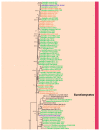A Review of the Fungi That Degrade Plastic
- PMID: 35893140
- PMCID: PMC9330918
- DOI: 10.3390/jof8080772
A Review of the Fungi That Degrade Plastic
Abstract
Plastic has become established over the world as an essential basic need for our daily life. Current global plastic production exceeds 300 million tons annually. Plastics have many characteristics such as low production costs, inertness, relatively low weight, and durability. The primary disadvantage of plastics is their extremely slow natural degradation. The latter results in an accumulation of plastic waste in nature. The amount of plastic waste as of 2015 was 6300 million tons worldwide, and 79% of this was placed in landfills or left in the natural environment. Moreover, recent estimates report that 12,000 million tons of plastic waste will have been accumulated on the earth by 2050. Therefore, it is necessary to develop an effective plastic biodegradation process to accelerate the natural degradation rate of plastics. More than 400 microbes have been identified as capable of plastic degradation. This is the first paper of the series on plastic-degrading fungi. This paper provides a summary of the current global production of plastic and plastic waste accumulation in nature. A list is given of all the plastic-degrading fungi recorded thus far, based on the available literature, and comments are made relating to the major fungal groups. In addition, the phylogenetic relationships of plastic-degrading fungi were analyzed using a combined ITS, LSU, SSU, TEF, RPB1, and RPB2 dataset consisting of 395 strains. Our results confirm that plastic-degrading fungi are found in eleven classes in the fungal phyla Ascomycota (Dothideomycetes, Eurotiomycetes, Leotiomycetes, Saccharomycetes, and Sordariomycetes), Basidiomycota (Agaricomycetes, Microbotryomycetes, Tremellomycetes, Tritirachiomycetes, and Ustilaginomy-cetes), and Mucoromycota (Mucoromycetes). The taxonomic placement of plastic-degrading fungal taxa is briefly discussed. The Eurotiomycetes include the largest number of plastic degraders in the kingdom Fungi. The results presented herein are expected to influence the direction of future research on similar topics in order to find effective plastic-degrading fungi that can eliminate plastic wastes. The next publication of the series on plastic-degrading fungi will be focused on major metabolites, degradation pathways, and enzyme production in plastic degradation by fungi.
Keywords: fungi; global plastic production; multi-gene phylogeny; plastic waste accumulation; synthetic polymers.
Conflict of interest statement
Authors declare that they have no competing interest.
Figures





References
-
- Ogunbayo A., Olanipekun O., Adamu I. Preliminary Studies on the Microbial Degradation of Plastic Waste Using Aspergillus niger and Pseudomonas sp. J. Environ. Prot. 2019;10:625–631. doi: 10.4236/jep.2019.105037. - DOI
-
- Baheti P. How Is Plastic Made? [(accessed on 15 September 2021)]. Available online: https://www.bpf.co.uk/plastipedia/how-is-plastic-made.aspx.
Publication types
Grants and funding
LinkOut - more resources
Full Text Sources

